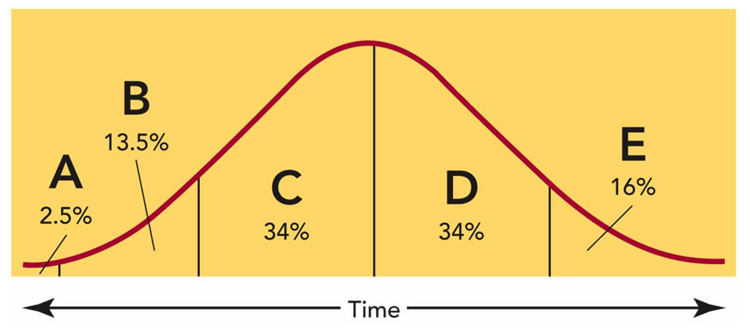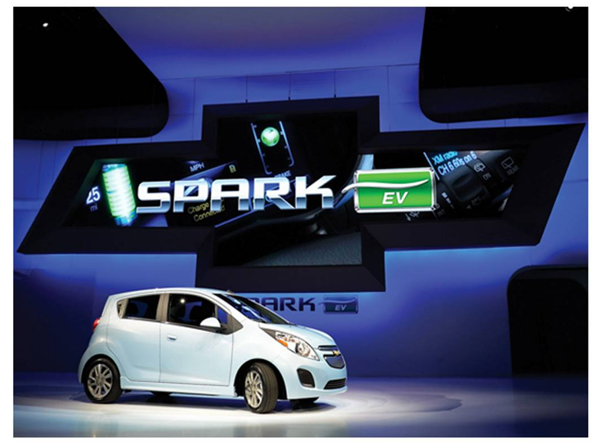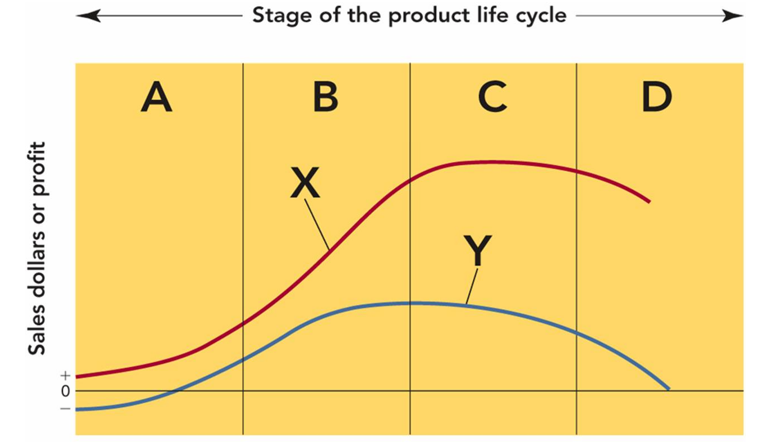A) reach a new market
B) catch a rising trend
C) change the value offered
D) change its target audience
E) react to a competitor's position
G) A) and B)
Correct Answer

verified
Correct Answer
verified
Multiple Choice
 -The consumers represented by D in Figure 10-4 above are called __________.
-The consumers represented by D in Figure 10-4 above are called __________.
A) innovators
B) late majority
C) early majority
D) early adopters
E) laggards
G) B) and D)
Correct Answer

verified
Correct Answer
verified
Multiple Choice
All of the following are types of barriers to the adoption of new products EXCEPT:
A) risk
B) regulatory
C) psychological
D) usage
E) value
G) D) and E)
Correct Answer

verified
Correct Answer
verified
Multiple Choice
Which of the following quotes from a new product adopter would signal the need for a firm to counteract a usage barrier?
A) "But it might make me fat."
B) "What if I can't make the monthly payments?"
C) "I don't want to try this if it means I have to swallow it with milk."
D) "Big deal, the only difference is the shape of the package."
E) "Sure I'll try it; why not!"
G) B) and C)
Correct Answer

verified
Correct Answer
verified
Multiple Choice
Which of the following is a characteristic of the growth stage of the product life cycle?
A) advertising emphasis switches to selective demand
B) a growing proportion of trial purchases come from brand loyal users
C) product features remain unchanged
D) profit margins increase as sales increase
E) the product is sold in a narrowly selected number of retail outlets
G) A) and E)
Correct Answer

verified
Correct Answer
verified
Multiple Choice
A branding strategy that involves giving each product a distinct name when each brand is intended for a different market segment is referred to as __________.
A) product differentiation branding
B) multibranding
C) mixed branding
D) segmentation branding
E) multiproduct branding
G) A) and C)
Correct Answer

verified
Correct Answer
verified
Multiple Choice
A manufacturer of a new all-natural-ingredient shampoo and conditioner puts free samples of the product in Sunday newspapers to __________.
A) simulate laggard usage of the product
B) inhibit the innovation diffusion process
C) encourage product trial and adoption
D) erect product adoption barriers against its competitors
E) circumvent the typical adoption cycle
G) B) and E)
Correct Answer

verified
Correct Answer
verified
Multiple Choice
Companies can employ four general branding strategies, which include: (1) multiproduct branding; (2) multibranding; (3) private branding; and (4) __________.
A) retailer branding
B) intermediary branding
C) brand licensing
D) mixed branding
E) co-branding
G) All of the above
Correct Answer

verified
Correct Answer
verified
Multiple Choice
The term branding refers to __________.
A) the licensing of a name, phrase, design, symbol, or combination of these for a period of 17 years, at which time a firm may renew its intellectual property rights to them
B) the value added to the product from the additional features given to a product beyond its functional attributes
C) the identification of an organization's products based upon individual SKUs
D) an organization's use of a name, phrase, design, symbol, or combination of these to identify its products and distinguish them from those of competitors
E) the establishment of a commercial, legal name under which a company does business
G) B) and D)
Correct Answer

verified
Correct Answer
verified
Multiple Choice
The largest numbers of product adopters with respect to the diffusion of innovation are found among __________.
A) innovators and laggards
B) early majority and late majority
C) late majority and laggards
D) innovators and early majority
E) innovators and early adopters
G) All of the above
Correct Answer

verified
Correct Answer
verified
Multiple Choice
Which of the following products would have a low-learning product life cycle curve?
A) electric cars
B) Fusion razor
C) interactive television
D) software for learning a foreign language
E) convection ovens
G) A) and C)
Correct Answer

verified
Correct Answer
verified
Multiple Choice
Service firms can manage their physical environment to influence customers' perceptions through
A) service delivery management.
B) relationship management.
C) customer experience management.
D) exposure management.
E) impression management.
G) A) and B)
Correct Answer

verified
Correct Answer
verified
Multiple Choice
Gillette spent $200 million in advertising to introduce the Fusion razor to male shavers. Such expenditures are often made to stimulate primary demand, or desire for the product __________, rather than for a specific brand, when there are few competitors with the same product.
A) class
B) form
C) item
D) mix
E) concept
G) All of the above
Correct Answer

verified
Correct Answer
verified
Multiple Choice
Three important aspects of product life cycles are their length, the shape of their sales curves, and the rate at which __________.
A) consumers recognize differences among products
B) consumers adopt products
C) consumers abandon products
D) competitors create competitive offerings
E) environmental forces affect products
G) All of the above
Correct Answer

verified
Correct Answer
verified
Multiple Choice
Multibranding refers to a branding strategy in which a firm __________.
A) gives each product a distinct name when each brand is intended for a different market segment
B) uses different brand names for the same product across multiple countries
C) uses one name for all its products in a product class
D) produces products but sell them under the brand name of a wholesaler or retailer
E) contractually, and for a fee, allows other firms to use its brand name, requiring that the product be made to its specifications
G) B) and C)
Correct Answer

verified
Correct Answer
verified
Multiple Choice
 -All electric-powered automobiles such as the Chevy Spark shown in the photo above are in which stage of their product life cycle?
-All electric-powered automobiles such as the Chevy Spark shown in the photo above are in which stage of their product life cycle?
A) growth
B) maturity
C) decline
D) accelerated development
E) introduction
G) A) and E)
Correct Answer

verified
Correct Answer
verified
Multiple Choice
Market modification refers to a marketing strategy that __________.
A) alters a product's characteristic, such as its quality, performance, or appearance, to increase its value to customers and to increase sales
B) manages a product's life cycle to find new customers, increase a product's use among existing customers, or create new use situations
C) tries to find new customers and convince users who abandoned the product to purchase again
D) drops the lowest producing market segment and replaces it with an entirely new one
E) combines the two lowest producing market segments to achieve marketing economies of scale
G) None of the above
Correct Answer

verified
Correct Answer
verified
Multiple Choice
What is the marketing objective for the introduction stage of the product life cycle?
A) harvesting
B) market share
C) stress differentiation
D) maintain brand loyalty
E) gain awareness
G) C) and D)
Correct Answer

verified
Correct Answer
verified
Multiple Choice
 -Figure 10-1 above represents the stages of the product life cycle. What does the curve labeled X represent?
-Figure 10-1 above represents the stages of the product life cycle. What does the curve labeled X represent?
A) total variable costs
B) total fixed costs
C) total industry profit
D) total industry sales revenue
E) total research and development costs
G) C) and D)
Correct Answer

verified
Correct Answer
verified
Multiple Choice
Product packaging, such as the Pringles cylindrical package, is one example of the product's __________.
A) functional benefits
B) convenience
C) communication benefits
D) technology
E) renewable resources
G) B) and C)
Correct Answer

verified
Correct Answer
verified
Showing 81 - 100 of 408
Related Exams